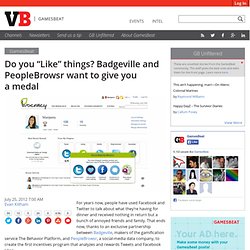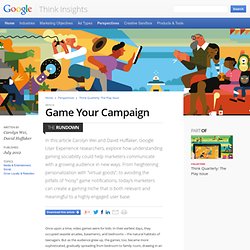

Infinite Scroll: The Web’s Slot Machine. Nir Eyal writes about the intersection of psychology, technology, and business at NirAndFar.com.

He is the author of the forthcoming book “Hooked: How to Drive Engagement by Creating User Habits”. Follow him on Twitter @nireyal. The Art and Science of Gamification. To recap quickly, in the first article we discussed the fact that 2012 is THE year for apps and how those who put on their ‘Appreneur' hats on & take action will find success.

Then in the second article, we talked about a theory that we referred to as 3D Internet that follows what we call ‘the deep then wide method;' through mobile apps, mobile devices are taking Google's ‘wide then deep method' of "searching" and flipping it! Apps allow for us to go deep and straight to the source and then go wide to find even more valuable content! In the last article, we talked about one of the hottest topics in business right now and that's behavioral analytics a.k.a the main reason Facebook acquired Instagram. Now, let's discuss another Top Topic... and that is, gamification. First, let's quickly go over what gamification actually is...
According to Wikipedia (our modern age dictionary): It's the use of game design techniques, game thinking and game mechanics to enhance non-game contexts. Do you “Like” things? Badgeville and PeopleBrowsr want to give you a medal. For years now, people have used Facebook and Twitter to talk about what they’re having for dinner and received nothing in return but a bunch of annoyed friends and family.

Game Your Campaign. Once upon a time, video games were for kids.

In their earliest days, they occupied seaside arcades, basements, and bedrooms – the natural habitats of teenagers. But as the audience grew up, the games, too, became more sophisticated, gradually spreading from bedroom to family room, drawing in an older generation. And yet, for the most part, these gaming adults were the same kids that had grown up in the 8-bit era – they were an interesting niche, but a relatively small one.
Then Facebook happened. This Is Your Brain On Boarding: How To Turn Visitors Into Users. Editor’s Note: Nir Eyal is a Lecturer in Marketing at the Stanford Graduate School of Business.

He is the founder of two startups and blogs about the intersection of psychology, technology, and business at NirAndFar.com. Follow him on Twitter @nireyal. Before you can change the world, before your company can IPO, before getting millions of loyal users to wonder how they ever lived without your service, people need to on-board. Building the on-ramp to using your product is critical in every industry, but few more so than in the ADD world of web and mobile apps.
Distractions are everywhere, vying for user mindshare and threatening to pull them off the road to using your products like the donut shops and strip clubs at a trucker’s rest stop. However, done correctly, the on-boarding process can be the first step in creating strong user habits. Gamification & Storytelling, histoire des jeux communicants 1/5. Le jeu et/ou les mécanismes ludiques sont des outils intéressants pour engager les cibles et les faire entrer dans une histoire. L’utilisation du jeu pour communiquer n’est pas récente. Certes, cet usage n’est pas aussi ancien que celui des histoires et des structures narratives, mais ses prémisses date d’avant le développement des technologies de l’information et de la communication. Balayons l’histoire du jeu communicant… Les jeux sont un loisir très ancien. Le jeu royal d’Ur, retrouvé en Mésopotamie au début du XXe siècle, date d’il y a plus de 4600 ans.
Le premier jeu à se parer de tels atours est les échecs. « L’origine du jeu d’échecs reste obscure : aussi de nombreuses légendes sont-elles venues au secours de l’histoire pour en expliquer la provenance, explique Constance Cousin, contributrice du site Historia Nostra. Un récit très storytelling ! Make Your Users Do the Work. Editor’s Note: Nir Eyal is a founder of two startups and an advisor to several Bay Area companies and incubators.
He is a Lecturer in Marketing at the Stanford Graduate School of Business and blogs about the intersection of psychology, technology, and business at NirAndFar.com. Follow him on Twitter @nireyal. The belief that products should always be as easy to use as possible is a sacred cow of the tech world. The rise of design thinking, coinciding with beautiful new products like the iPhone, has led some to conclude that creating slick interfaces is a hallmark of great design. But, like all attempts to create absolute rules about how we should interact with technology, the law that design should always decrease the amount of effort users expend doesn’t always hold true. Several studies have shown that expending effort on a task seems to commit us to it.
However, the opposite is true.
Gamification et entreprises. UX. Applis et sites gamifiés. Gamification et éducation. L'ampleur de la gamification.